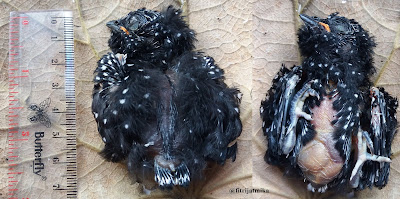This baby bird was found dead. Maybe it fell from the tree. I don't know what is this. I tried to ask the local name to the local people, but unfortunately, they didn't know.
Bayi burung ini ditemukan sudah mati. Mungkin jatuh dari pohon. Saya tidak tahu jenis burung apa. Saya mencoba bertanya nama lokalnya pada warga sekitar tapi sayangnya mereka juga tidak tahu.
The length of its body about 7 cm. Polkadot feathers, ground colour black and ornated by white dots that spread all over their feathers. Almost all parts of its body are covered by its feathers, except the breast, belly and tarsus. At the breast and belly, besides not covered by the feathers, the skin is thin. So, we can see some of the internal organs.
Panjang tubuhnya sekitar 7 cm. Bulunya polkadot, dengan warna dasar hitam dan dihiasi titik-titik putih ini tersebar di seluruh bulunya. Hampir semua bagian tubuhnya tertutup dengan bulu, kecuali bagian dada, perut dan kaki. Pada bagian dada dan perutnya selain tidak tertutup bulu, kulitnyapun tipis sehingga kita dapat melihat beberapa organ dalamnya.
In addition, the beak, back (dorsal) skin and the tarsus colours are black. The base of the beak (gape) is orange. According to the beak form, it's grain eating type.
Selain itu, paruh, kulit bagian punggung (dorsal) dan juga kakinya berwarna hitam. Pangkal parunya (gape) berwarna jingga. Dilihat dari bentuknya burung ini termasuk burung pemakan biji.
(Peru Aves, -)
(Vendantam, et al., 2017)
References
Peru Aves. -. Bird Topography. Accessed on 6th February 2019.
Vendantam, R. Bengio, S. Murphy, K., Parikh, D and Gal Chechik. 2017. Context-aware Captions from Context-agnostic Supervision.



Comments
Post a Comment